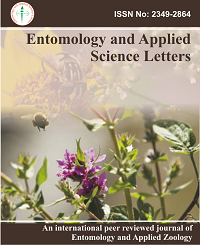
Applied Science Letters


Farm management methods have always used pesticides to mitigate the pests and improve the crop yields. This study investigated the population structures of Mango leafhopper, Idioscopus clypealis in mango orchards unsprayed or sprayed with pesticides. The analysis of the populations was based on the wing shapes used by insects to fly. Geometric and morphometric techniques were used to analyze the shapes of the forewings of the pest. The results of the thin plate spline image showed asymmetry in the left and right wings in the two sexes of the insect pest. The relative warp analysis showed that wing shapes of insects in the unsprayed orchard had a mean shape close to the consensus wing shape unlike those populations where there was a routine application of pesticides. The differences in wing shapes of the populations collected from unsprayed and sprayed orchards were argued to be due to the effects of pesticides.
National Institutes of Environmental Health Sciences (NIEHS). Pesticides. 2017. Accessed at
World Health Organization (WHO). Pesticides. 2017. Accessed at
Mallet J. The evolution of insecticide resistance: have the insects won? Trends in ecology & evolution. 1989; 4(11):336-40.
Sparks TC, Nauen R. IRAC: Mode of action classification and insecticide resistance management. Pesticide Biochemistry and Physiology. 2015; 121:122-8.
Environmental Protection Agency (EPA). Pesticides. 2017. Accessed at
National Pesticide Information Center (NPIC). Pesticides. 2016. Accessed at
Bass C, Denholm I, Williamson MS, Nauen R. The global status of insect resistance to neonicotinoid insecticides. Pesticide Biochemistry and Physiology. 2015; 121:78-87.
Devonshire AL, Field LM, Foster SP, Moores GD, Williamson MS, Blackman RL. The evolution of insecticide resistance in the peach–potato aphid, Myzus persicae. Philosophical Transactions of the Royal Society of London B: Biological Sciences. 1998; 353(1376):1677-84.
Tabashnik BE, Van Rensburg JB, Carrière Y. Field-evolved insect resistance to Bt crops: definition, theory, and data. Journal of economic entomology. 2009; 102(6):2011-25.
AJ, Petzold-Maxwell JL, Clifton EH, Dunbar MW, Hoffmann AM, Ingber DA, Keweshan RS. Field-evolved resistance by western corn rootworm to multiple Bacillus thuringiensis toxins in transgenic maize. Proceedings of the National Academy of Sciences. 2014; 111(14):5141-6.
Lockwood JA, Sparks TC, Story RN. Evolution of insect resistance to insecticides: a reevaluation of the roles of physiology and behavior. Bulletin of the Ent. Soc. Amer., 1984; 30(4):41-51.
Despres L, David JP, Gallet C. The evolutionary ecology of insect resistance to plant chemicals. Trends in ecology & evolution. 2007; 22(6):298-307.
Facknath S, Stewart-Jones A, Wright DJ. Neem chemicals disturb the behavioral response of Liriomyza huidobrensis to conspecific-induced potato volatiles. Pure and Applied Chemistry. 2009; 81(1):85-95.
Nansen C, Baissac O, Nansen M, Powis K, Baker G. Behavioral avoidance-will physiological insecticide resistance level of insect strains affect their oviposition and movement responses? PloS one. 2016; 11(3): e0149994. https://doi.org/10.1371/journal.pone.0149994
Jürgens A, Bischoff M. Changing odour landscapes: The effect of anthropogenic volatile pollutants on plant–pollinator olfactory communication. Functional Ecology. 2017; 31(1):56-64.
Gould F. Role of behavior in the evolution of insect adaptation to insecticides and resistant host plants. Bulletin of the ESA. 1984; 30(4):34-41.
Szentgyörgyi H, Moroń D, Nawrocka A, Tofilski A, Woyciechowski M. Forewing structure of the solitary bee Osmia bicornis developing on heavy metal pollution gradient. Ecotoxicology. 2017; 26(8):1031-40.
Nattero J, Dujardin JP, del Pilar Fernández M, Gürtler RE. Host-feeding sources and habitats jointly affect wing developmental stability depending on sex in the major Chagas disease vector Triatoma infestans. Infection, Genetics and Evolution. 2015; 36:539-46.
CP. Evolution and development of shape: integrating quantitative approaches. Nature Reviews Genetics. 2010; 11(9):623.
TM, Grassi ML, Imperatriz-Fonseca VL, de Jesús May-Itzá W, Quezada-Euán JJ. Geometric morphometrics of the wing as a tool for assigning genetic lineages and geographic origin to Melipona beecheii (Hymenoptera: Meliponini). Apidologie. 2011; 42(4):499.
Fletcher MJ, Dangerfield PC. Idioscopus clypealis (Lethierry), a second new leafhopper pest of mango in Australia (Hemiptera: Cicadellidae: Idiocerinae). Austral Entomology. 2002; 41(1):35-8.
Rohlf, F. J. tps Utility program version 1.44. Ecology and Evolution. SUNY, Stony Brook. 2009. Accessed at
Rohlf, F. J. tpsDig program version 2.12. Ecology and Evolution. SUNY, Stony Brook. 2008. Accessed at
Hammer Ø, Harper DA, Ryan PD. Paleontological statistics software: package for education and data analysis. Palaeontologia Electronica, 2001; (4). 9pp. http://palaeo-electronica.org/2001_1/past/issue1_01.htm.
Dryden IL, Mardia KV. Statistical shape analysis. Chichester: Wiley; 1998 Jul.
Adams DC, Rohlf FJ, Slice DE. Geometric morphometrics: ten years of progress following the ‘revolution’. Italian Journal of Zoology. 2004; 71(1):5-16.
Rohlf, F. J. Relative warps program version 1.46. Ecology and Evolution. SUNY, Stony Brook. 2008. Accessed at
Bookstein, F. L. Thin-plate splines and the atlas problem for biomedical images. In Biennial International Conference on Information Processing in Medical Imaging 1991 Jul 7 (pp. 326-342). Springer, Berlin, Heidelberg.
Rohlf FJ. Relative warp analysis and an example of its application to mosquito. Contributions to morphometrics. 1993; 8:131.
Chapman RF. The insects: structure and function. Cambridge university press; 1998 Nov.
